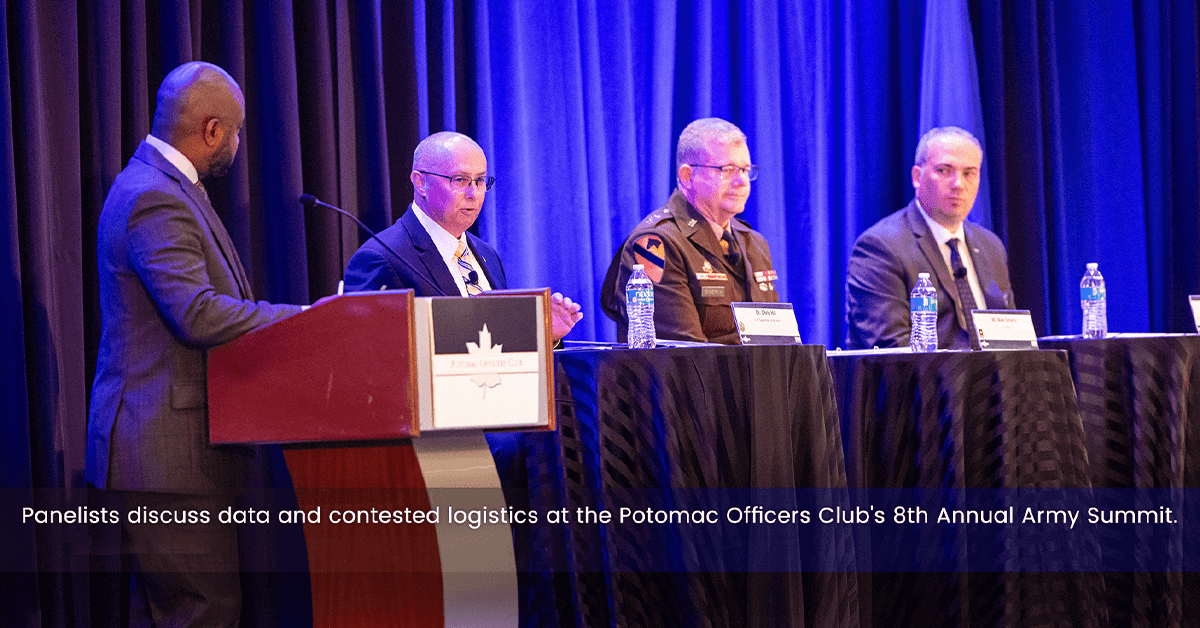Data is continuously transforming all facets of the modern battlefield, and recognizing its potential, the U.S. Army is working to unlock the benefits it offers for the warfighter. One area in which data has huge potential is contested logistics, which has evolved along with technology.
“When you hear ‘contested logistics,’ it’s always been consistent or contested at the tactical level. It’s now the breadth from tactical to strategic that’s different,” explained Maj. Gen. Mark Simerly, commanding general of the U.S. Army Combined Arms Support Command and Sustainment Center of Excellence at the Training and Doctrine Command.
“Every line of communication is contested, extended and congested, and of course, our ability to communicate is also denied, degraded, intermittent and limited, and as a result, all sustainment operations will be distributed, dispersed and disrupted,” he said during a panel discussion at the Potomac Officers Club’s 8th Annual Army Summit last week.
Dr. Chris Hill, chief data and analytic officer for the U.S. Army Materiel Command, shared that his recent experiences have demonstrated that contested logistics – and all areas of the battlefield – are now about speed and scale.
“Because of the modernization of the battlefield, commanders are able to have visibility of the battlefield at unprecedented levels, and they make decisions that cause operations to shift and change at really quick rates,” he elaborated.
Simerly noted that one way the Army is looking to adapt to and address these challenges is with predictive logistics.
“As we think about linking sensors to shooters, we’re also thinking about linking sensors to shooters to sustainers within that network, and predictive logistics is the network that provides a suite of solutions to harness the power of data,” Simerly explained.
He added that predictive logistics enables the Army to achieve the four tenets of multi-domain operations and provides “the opportunity to create and exploit relative physical information and human advantages and pursuit of decision dominance.”
Terrance Westerfield, who oversees DOD strategy for the U.S. Army at Amazon Web Services, noted the importance of both short-term and long-term forecasting. Responding quickly to immediate demands, he said, is something that could benefit from strategies more commonly used in industry, such as pre-positioning supplies.
Precision sustainment is another important part of logistics, according to Hill.
He explained the term, which considers both threats and geographical characteristics as determining factors in logistics approaches. Today, he said, these influences can often create a need for the Army to veer away from traditional logistics strategies. To tackle these challenges, he said, the Army is bringing data to the tactical edge and using open architectures and common programming languages to engage multiple partners in the fight.
Westerfield noted the Army’s goal of building platforms that fight in formations and said that sustainment is “the key” to achieving this objective and emphasized that no logistics means no order.
“One of the things that we look at is how we can enable that from not only the end item – consumption of the materials, supplies or fuel – but also feeding all the way back into those automated processes for predictive analytics, predictive consumption rates and predictive resupply and reorder,” he said.
Another element of this assessment, he added, is considering how a broken piece of equipment can be sent back to the field as quickly as possible.
Though algorithms are important, they are not the only way to properly forecast requirements. Sometimes, he noted, predictions can be achieved just with data linkages.
“Even in cases where the data is really bad or we’re not sure what’s gonna happen, we can go back to some of the old fashioned operations research tools to give that commander a decision space,” he said, adding that this combination has been successful.


The Potomac Officers Club is taking another look into major Department of Defense priorities with its Integrating for Mission Success Forum, which will convene experts to consider the importance of interoperability on the modern battlefield on August 10. To learn more and register to attend, click here.





